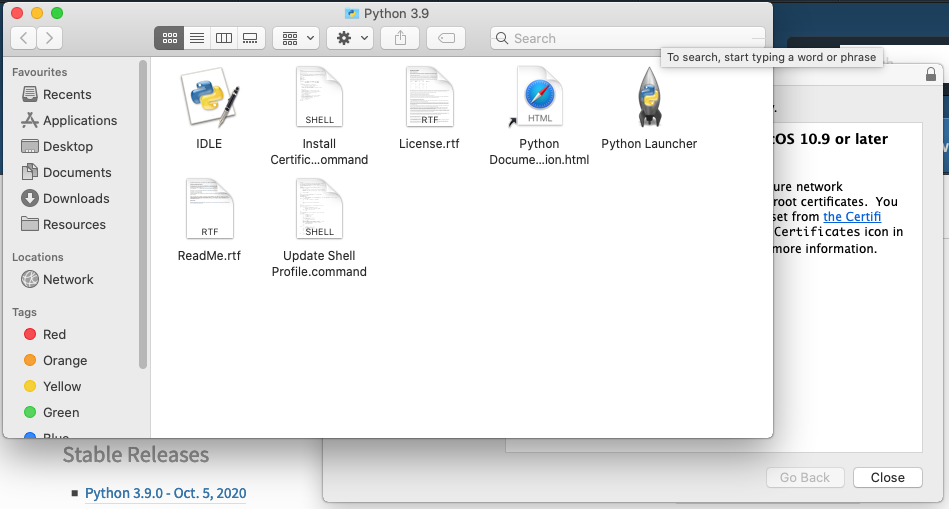Step 2: Remove the Python Framework from the /Library directory. We will use the command line starting from this step. Press command + space to bring up the Spotlight Search. Search for Terminal and open it. In the terminal type the following command to remove all the Python Frameworks present in the /Library directory and hit enter. I'm attempting to get a working version of python3 installed on a mac running Catalina (10.15.7).Calling python3 from the terminal ultimately errors with a software. Pip is a tool for easily installing and managing Python packages, that is recommended over easyinstall. It is superior to easyinstall in several ways, and is actively maintained. $ pip2 -V # pip pointing to the Homebrew installed Python 2 interpreter $ pip -V # pip pointing to the Homebrew installed Python 3 interpreter (if installed). The automated Travis Continuous Integration build could be tackled after that. The build steps start with the.travis.yml file, which calls package/prepareosx.sh to install Manuskript and the required software (e.g., python). Gedakc mentioned this issue on Jan 15, 2020. Manuskript 0.11.0 release check list #716.
I'm still working on getting pyenv in my bloodstream. It seems like totally the right tool for having different versions of Python available on macOS that don't suddenly break when you run brew upgrade periodically. But every thing I tried failed with an error similar to this:

I read through the Troubleshooting FAQ and the 'Common build problems' documentation. xcode was up to date and I had all the related brew packages upgraded. Nothing seemed to work.
Until I saw this comment on an open pyenv issue: 'Unable to install any Python version on MacOS'
All I had to do was replace the 10.14 for 10.15 and now it finally worked here on Catalina 10.15. So, the magical line was this:
Hopefully, by blogging about it you'll find this from Googling and I'll remember the next time I need it because it did eat 2 hours of precious evening coding time.
Related posts
- Previous:
- redirect-chain - Getting a comfortable insight input URL redirects history14 February 2020
- Next:
- How to install Node 12 on Ubuntu (Eoan Ermine) 19.1008 April 2020
- Related by category:
- How much faster is Redis at storing a blob of JSON compared to PostgreSQL?28 September 2019Python
- Best practice with retries with requests19 April 2017Python
- Fastest way to find out if a file exists in S3 (with boto3)16 June 2017Python
- Interesting float/int casting in Python25 April 2006Python
- Fastest way to unzip a zip file in Python31 January 2018Python
Pip broken under Mac OS X Catalina? TLDR;
Install Python On Mac Catalina
pip install --global-option=build_ext --global-option='-I/Library/Developer/CommandLineTools/SDKs/MacOSX.sdk/usr/include/' --global-option='-L/Library/Developer/CommandLineTools/SDKs/MacOSX.sdk/usr/lib/' --prefer-binary -r requirements.txt
As Apple has announced, Mac OS Catalina now runs under its own read only file system:
Install Python Mac Catalina Update
macOS Catalina runs on a dedicated, read-only system volume called Macintosh HD. This volume is completely separate from all other data to help prevent the accidental overwriting of critical operating system files. [1]
Sounds great. But if you need to change that volume, or if you use software that expects to be able to find files on that read only volume that aren't there and can't be added, you're kind of stuck.
One example is Python's pip which, for some packages, will expect to find header files located in /usr/include. Apple gave developers a get-out-of-jail-free card in Mojave:
As a workaround, an extra package is provided which will install the headers to the base system. In a future release, this package will no longer be provided. [2]
and in true Apple fashion, the package was taken away. This creates problems if you want to install commonly used, but maybe not so commonly maintained, libraries. One example is Pillow, an image processing library. This will well and truly fail to compile if you just try pip install Pillow. It looks for the headers and libraries, and doesn't find them.
What can we do? Well, for pip there's a few options. The first is simply not to compile at all, but to prefer a binary. This is as simple in some cases as the --prefer-binary option. But what if, like Pillow, there is no precompiled binary for your platform? Or for reasons of information security, you have to compile it yourself?
Install Python 3 Mac Catalina
Fortunately, pip can be directed to look in different places using the 'global-options' flag. To get Pillow to build, use the command at the top of this article, reproduced below:
pip install --global-option=build_ext --global-option='-I/Library/Developer/CommandLineTools/SDKs/MacOSX.sdk/usr/include/' --global-option='-L/Library/Developer/CommandLineTools/SDKs/MacOSX.sdk/usr/lib/' --prefer-binary -r requirements.txt
To understand this more fully, take a look at https://stackoverflow.com/questions/18783390/python-pip-specify-a-library-directory-and-an-include-directory.
If you need to do a similar function as part of other install tools, common environment variables are LD_LIBRARY_PATH (deprecated[3], but still commonly used), LIBRARY_PATH and INCLUDE_PATH. Setting these to the library paths (/Library ... /usr/lib) and include paths (/Library ... /usr/include) respectively may help.
Install Python Mac Catalina Operating System

[1]https://support.apple.com/en-gb/HT210650
[2]https://developer.apple.com/documentation/xcode_release_notes/xcode_10_release_notes#3035624
[3]https://stackoverflow.com/questions/18241517/c-include-path-vs-ld-library-path